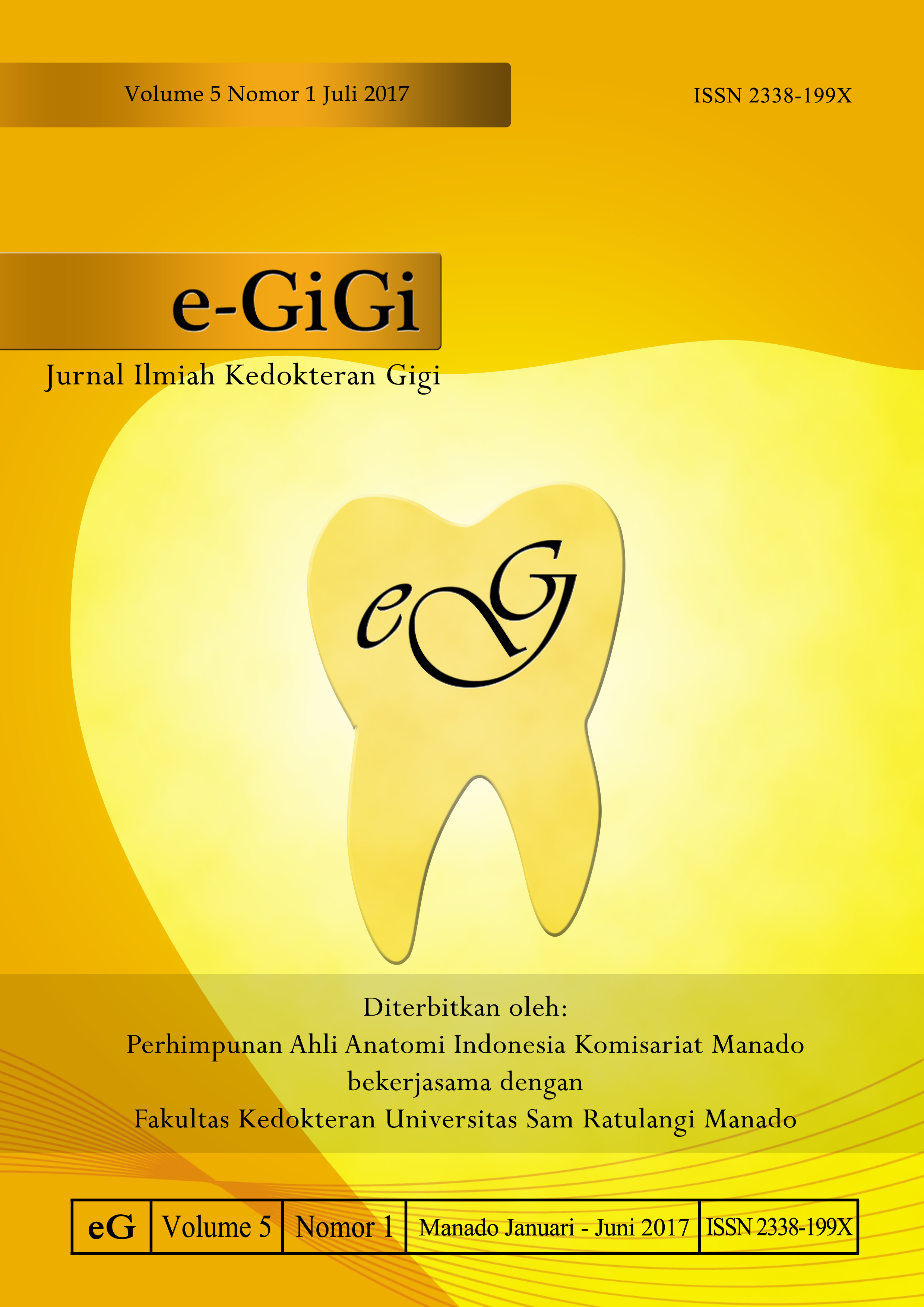Status kebersihan gigi dan mulut berdasarkan cara menyikat gigi dengan teknik kombinasi pada anak kidal dan non-kidal
DOI:
https://doi.org/10.35790/eg.5.1.2017.15525Abstract
Abstract: During the developmental stage, children begin to do a variety of activities including tooth brushing. Generally, children use their right hands dominantly to do their activities (right-handed), however, there are also children who use their left hands (left-handed) dominantly. This study was aimed to assess the oral hygiene status based on tooth brushing with a combination technique among left-handed and right-handed children. This was a descriptive study with a cross-sectional design. Population study consisted of left-handed and right-handed children at Kalawat, North Minahasa, North Sulawesi province. Respondents were 60 children consisted of 30 left-handed children and 30 right-handed children obtained by using the purposive sampling method. Data were obtained by using checking form of oral hygiene status. The results showed that oral hygiene status of most left-handed and right-handed children was in good category. The average of OHI-S score of the left-handed children before tooth brushing was 0.7 and after tooth brushing was 0.3, whereas, of the right-handed children, the average of OHI-S score before tooth brushing was 0.6 and after tooth brushing was 0.2. Conclusion: Oral hygiene status of right-handed children who brushed their teeth with a combination technique was better than of the left-handed children.
Keywords: oral hygiene status, left-handed children, right-handed children, tooth brushing, combination technique
Abstrak: Seiring berjalannya tahap perkembangan, anak-anak mulai melakukan aktivitas termasuk menyikat gigi. Umumnya anak dominan melakukan aktivitas menggunakan tangan kanan (non-kidal) tetapi ada juga yang dominan melakukan aktivitas menggunakan tangan kiri (kidal). Penelitian ini bertujuan untuk mendapatkan status kebersihan gigi dan mulut nerdasrkan cara menyikat gigi dengan teknik kombinasi pada anak kidal dan non-kidal. Jenis penelitian ialah deskriptif dengan desain potong lintang. Populasi penelitian ialah anak kidal dan non-kidal di Kecamatan Kalawat Kabupaten Minahasa Utara Provinsi Sulawesi Utara. Jumlah responden sebanyak 60 orang anak terdiri dari 30 anak kidal dan 30 anak non-kidal diambil dengan metode purposive sampling. Pengumpulan data menggunakan formulir pemeriksaan status kebersihan gigi dan mulut. Hasil penelitian menunjukkan status kebersihan gigi dan mulut pada anak kidal dan anak non-kidal sebagian besar memiliki kategori baik. Rerata skor OHI-S anak kidal sebelum menyikat gigi yaitu 0,7 dan sesudah menyikat gigi 0,3 sedangkan pada anak non-kidal rerata skor OHI-S sebelum menyikat gigi 0,6 dan sesudah menyikat gigi 0,2. Simpulan: Status kebersihan gigi dan mulut berdasarkan cara menyikat gigi menggunakan teknik kombinasi pada anak non-kidal lebih baik dibandingkan pada anak kidal.
Kata kunci: status kebersihan gigi dan mulut, anak kidal, anak non-kidal, menyikat gigi teknik kombinasi.
Downloads
How to Cite
Issue
Section
License
COPYRIGHT
Authors who publish with this journal agree to the following terms:
Authors hold their copyright and grant this journal the privilege of first publication, with the work simultaneously licensed under a Creative Commons Attribution License that permits others to impart the work with an acknowledgment of the work's origin and initial publication by this journal.
Authors can enter into separate or additional contractual arrangements for the non-exclusive distribution of the journal's published version of the work (for example, post it to an institutional repository or publish it in a book), with an acknowledgment of its underlying publication in this journal.
Authors are permitted and encouraged to post their work online (for example, in institutional repositories or on their website) as it can lead to productive exchanges, as well as earlier and greater citation of the published work (See The Effect of Open Access).






